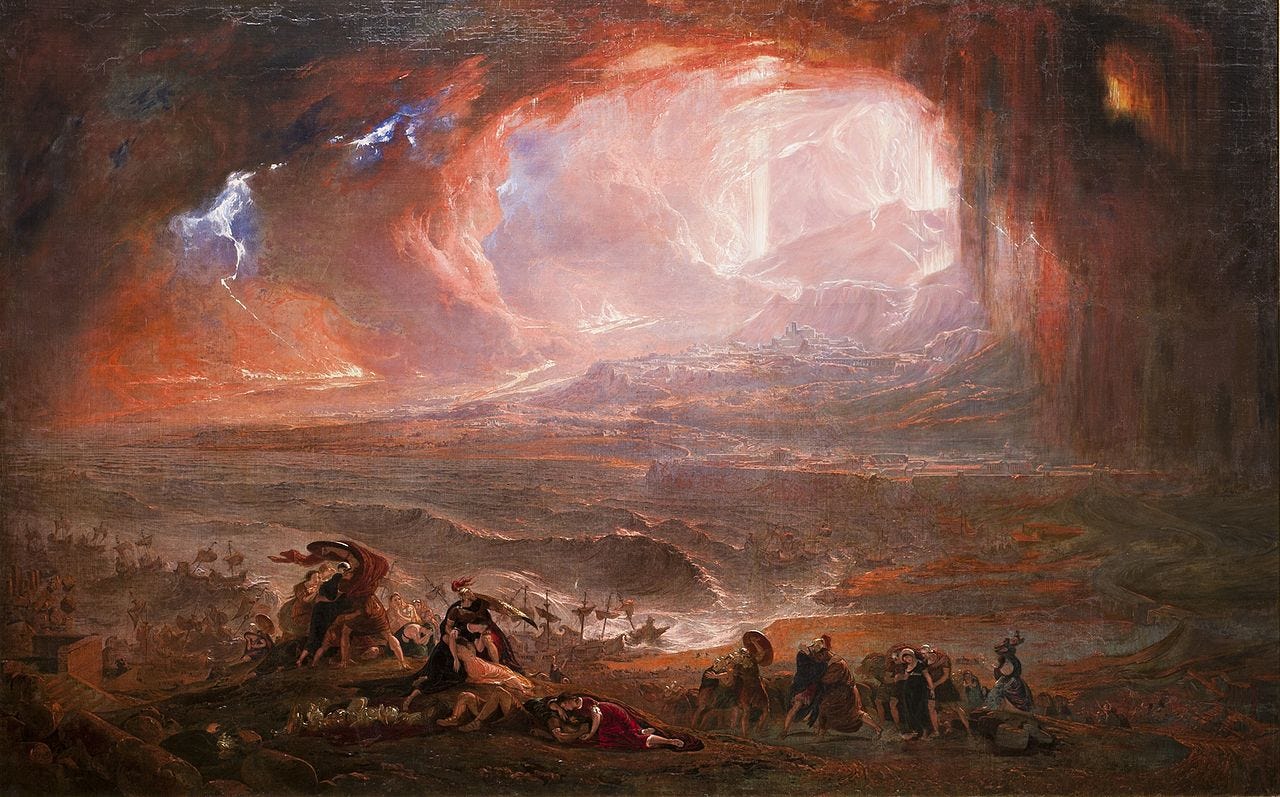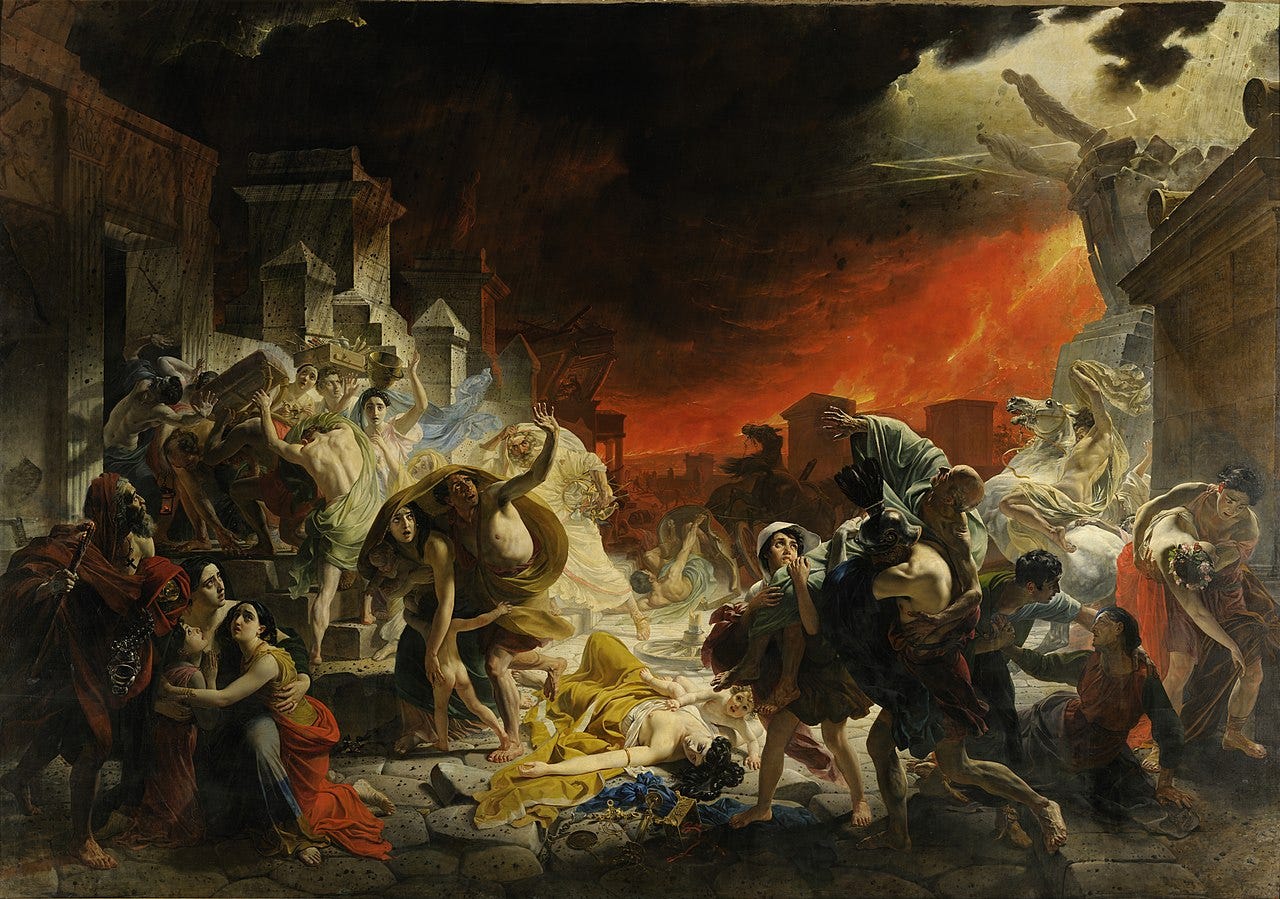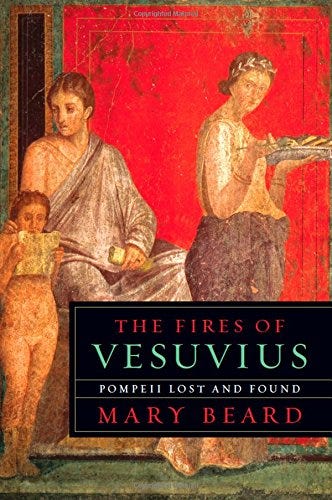1,994 Years Ago Today Vesuvius 🌋Destroyed Pompeii
Plus your chance to win a novel by six bestselling authors about the tragic event, A DAY OF FIRE

When Vesuvius erupted on this day, August 24th, nearly 2,000 years ago in 79 AD, the towns of Pompeii and Herculaneum near the Bay of Naples were suddenly and dramatically destroyed. Pliny the Younger, who witnessed the eruption some 20 miles away from Misenum across the bay, wrote two invaluable eyewitness letters detailing his observations, which you can hear in this video:
His letters also recount the tragic fate of his uncle, Pliny the Elder, a well-known author and naturalist. When news of the eruption reached Misenum, Pliny the Elder decided to sail closer to Vesuvius to observe the phenomenon and provide aid to those in distress. He took ships across the bay, and according to Pliny the Younger's account, his uncle was unable to escape the deadly effects of the eruption.
Pliny the Elder reached Stabiae, where he observed the eruption and planned to rescue friends. However, as the situation worsened, he was overtaken by toxic fumes and other adverse conditions related to the eruption. Despite attempts to move away from the danger, Pliny the Elder died, possibly as a result of inhaling the toxic gases. His body was later found on the beach with no apparent injuries, suggesting that it was the fumes rather than falling debris that caused his death.
In his letters, Pliny the Younger described how an enormous ash-bearing cloud arose from Vesuvius with immense speed and force, reaching extreme heights. He recounted how people seeking shelter were overwhelmed by falling ash and pumice, and how the trunks of uprooted trees were borne along.
Along with Pliny's descriptions, later excavations have provided valuable insights into the tragedy. The 18th-century antiquarian Winckelmann detailed his excavations at Herculaneum, uncovering everywhere a thick dust of lapilli, even tightly packed into crevices. Centuries later, excavations continue to retrieve remains like casts of perishable objects and the frozen attitudes of those instantly preserved in volcanic tuff.
The absolute erasure of landscapes, wildlife, and entire cities in a matter of hours served as a vivid reminder of humanity's fragility in the face of nature's overwhelming forces. The fate of Pliny the Elder, a prominent figure of his time, underscores the indiscriminate power of natural disasters, a lesson that resonates to this day.
They’re always discovering new things in the excavation of Pompeii, including this week’s news about finding a slave’s room, with a bed and cabinets.
The eruption of Mount Vesuvius and the subsequent destruction of Pompeii and Herculaneum have captured the imagination of many artists, filmmakers, and writers.
One of the most famous paintings is “The Last Day of Pompeii” by Karl Bryullov, a Russian painter who visited Pompeii in 1828.
It was the first Russian artwork to create a buzz across the world, inspiring many creative works, including a poem by Alexander Pushkin and the novel The Last Days of Pompeii by Edward Bulwer-Lytton, the latter of which inspired no less than eight films and one Italian mini-series.
A while back I saw that this print, The Great Eruption of Mount Vesuvius, was for sale, for $13K (it appears to have since sold) and wished I could have bought it. It’s a collaboration between Louis Jean Desprez and Francesco Piranesi. I love the way the color and the light bring drama to the image.
And I especially love this Warhol image of the volcano, one of several that he did.
You may recall the movie Pompeii (2014) - This film directed by Paul W.S. Anderson is set in the days leading up to the eruption, blending historical events with a fictional love story, and hunky Kit Harrington. It wasn’t the best movie, but it wasn’t the worst. However, IMHO, Kiefer Sutherland was a weird casting choice for the villain.
Let’s turn the page to books. Pompeii: A Novel by Robert Harris is a 2002 novel that I found inspirational when I was researching Feast of Sorrow. This historical thriller focuses on a hydraulic engineer who discovers something amiss with the aqueducts in the days leading up to the eruption. It’s especially good as an audio book.
For non-fiction, Mary Beard’s excellent The Fires of Vesuvius brings that day to life and catalogs all the ways it has impacted history.
And that brings us to another book…
You can win this novel of Pompeii, A Day of Fire!
From six bestselling authors, Victoria Alvear, Stephanie Dray, Ben Kane, Eliza Knight, Sophie Perinot, and Kate Quinn, comes a vividly imagined novel, A Day of Fire, following the lives of those in ancient Pompeii on the fateful day Mount Vesuvius erupts. Six authors bring to life overlapping stories of patricians and slaves, warriors and politicians, villains and heroes who cross each other’s paths during Pompeii’s fiery end. But who will escape, and who will be buried for eternity?
Do you want to win this book?
This giveaway closed at midnight on 8/27/23. Winners will be notified within 48 hours of the giveaway close and announced in my next newsletter/post.
A couple of things: you must be 18+ and a United States resident (pesky international laws make it tricky to do giveaways worldwide). If you are someone who loves rules, you can find the obligatory rules info here.
What’s Bringing Me Joy This Week:
This funny clip from the 1982 BBC show “Play for Tomorrow,” and what they thought virtual reality would be like. Note there is a little bit of mild, artistic nudity in it. I love that they thought we’d all be wearing satin! Also, I am jealous. Those glasses look way more comfortable than today’s VR headsets!
I asked https://dreamdecoder.me to help me understand one of my weird dreams and it was pretty amazing how spot-on it was. A fun, interesting use of AI.
British talk show host Michael Parkinson recently passed away. Here he is in a really delightful interview with Miss Piggy and Kermit.
Thanks for Joining Me
If you love food and love Italy, and haven’t read THE CHEF’S SECRET or FEAST OF SORROW, click the links to learn where to buy your copy! 🍒🍗🍷
You can also follow me in these places too:
Website | Instagram | Facebook | Mastodon | Threads











Thanks Crystal for an interesting insight into ancient history that reminded me of the current natural disaster in Maui. Cosmic threads continue through the centuries.
The Night Villa by Carol Goodman is kind of a fun historical fiction read in which the Vesuvius eruption figures prominently.